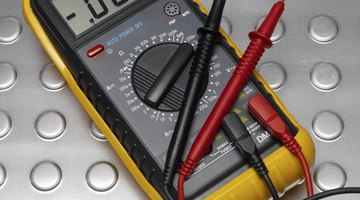How to Read a 4-20 mA Signal on a Multimeter
Electrical devices which provide a 4-20 mA (milliamp) signal are important tools for providing reliable communication between sensors and control devices over long distances. Analog 4-20 mA signals are used in many processes, including chlorination of water, vibration monitoring, pressure sensing and climate control.

In process water chlorination, sensors detect chlorine levels and send signals to a controller. The controller then sends a 4-20 mA analog signal to a chemical pump. At 4 mA, the pump is turned off, and at 20 mA, chlorine is pumped at a maximum rate. As the level of chlorine rises in the water, the signal level decreases until the pump turns off a 4 mA. This type of control system is called a proportional feed loop. Analog current signals are also used for data logging.
Things You Will Need
- Multimeter with alligator clamps
- Process sensor
- Controller or DC power supply
- 4-20 mA loop isolator (optional)
- 3-conductor, twisted, shielded wire, 16-18 gauge
-
Mount the sensor in an appropriate location for monitoring your process and connect the shielded electrical wiring from its sensor terminals to the controller terminals. If the controller does not supply power to the sensor, connect an appropriately sized DC power supply in series on one side of the loop. The controller or data logger circuitry will have terminals for a 4-20 mA signal. Connect the wiring according to the indications for polarity. In some cases, the controller generates a 4-20 mA signal based on voltage readings from sensors. Use shielded wiring to connect to these terminals and downstream controllers or data loggers.
-
Install a 4-20 mA loop isolator device to provide protection for the signal in the event of multiple connections of the loop and conditions where there may be feedback. This would apply when there are controller and datalogger connections for a single loop. Isolators are also recommended when inductive interference comes from nearby electronic devices.
-
Power up the instrumentation and the process to be monitored. Test the sensor for correct operation. For controllers with digital or analog readouts that are independent of the 4-20 mA loop, verify the calibration of the sensor. Use process-specific instrumentation or test kits to independently verify the process conditions and perform calibrations. Make adjustments in the controller as needed. If there are no process controllers between the sensor and the device that receives the 4-20 mA signal, proceed to the next step.
-
Test the 4-20 mA loop at the full range of conditions for the process. First, determine that the 4 mA signal is being produced under conditions where controls are not required. Measure the amperage in series (a wire on one of the terminals is disconnected to insert the meter leads between the terminal and wire). Begin the process to be measured and test its parameters, using an independent means of measurement. For climate conditions, use the instrumentation to measure these parameters. For chemical processes, use meters or chemical test kits that can confirm the range of conditions. If it is possible, adjust the maximum mA output of the sensor to be proportional to the limits of the process conditions.
Tip
Long runs of parallel wiring from other processes can cause induced currents, which interfere with the control signal. Having a separate pathway for the control wires can help avoid this signal interference. Ground the shield on only one end of the cable. A resistor in a series anywhere in the loop can provide a point of access for measurement purposes.
Warning
Use the proper precautions when working with electricity.
The Drip Cap
- Electrical devices which provide a 4-20 mA (milliamp) signal are important tools for providing reliable communication between sensors and control devices over long distances.
- In some cases, the controller generates a 4-20 mA signal based on voltage readings from sensors.
- Use shielded wiring to connect to these terminals and downstream controllers or data loggers.
- For controllers with digital or analog readouts that are independent of the 4-20 mA loop, verify the calibration of the sensor.
- Begin the process to be measured and test its parameters, using an independent means of measurement.
- For chemical processes, use meters or chemical test kits that can confirm the range of conditions.
References
Resources
Writer Bio
As a scientist, Randy McLaughlin has been a professional technical writer since 1980. He has a Master of Science from Texas A&M University and a Ph.D. in plant pathology from the University of Wisconsin. McLaughlin covers diverse topics, including Costa Rica, technical guides, alternative healing and spiritual development.
Photo Credits
- Polka Dot Images/Polka Dot/Getty Images
- Polka Dot Images/Polka Dot/Getty Images
More Articles



